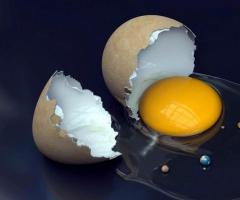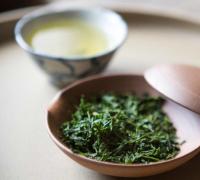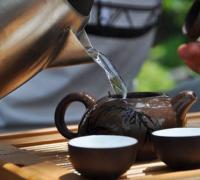Sencha green tea China. Description of sencha tea and its medicinal properties. Sencha tea - beneficial properties
Green tea is a perennial shrub whose young leaves are collected, dried and used to prepare the drink. Tea bushes are grown in ecologically clean mountain areas. We can talk endlessly about the benefits of different varieties of this product. But among them, sencha tea stands out.
The presented exquisite drink has a fresh taste, an invigorating effect and quenches thirst. Tea contains an analogue of caffeine - theine, it has a mild effect and gives the body more energy than strong, freshly brewed coffee, it also has the ability to improve mood and increase performance.
People who regularly consume sencha green tea experience good health, excellent mood, high productivity, energy and fresh, healthy skin color. This effect occurs due to the high content of beneficial minerals and trace elements in the drink.
The composition of tea has a positive effect on the entire body. Strengthens the immune system, normalizes metabolism, gives health to nails and hair, and perfectly cleanses the digestive tract. If you adhere to any diet, green tea is an integral part of it, since it has no calories, saturates the body with useful substances, and suppresses the feeling of hunger without causing harm to health.
Differences between Chinese and Japanese Sencha tea
How does Japanese sencha tea differ from its counterparts? These are the young top leaves of matcha or batcha tea, which are carefully harvested in April. The taste of the drink is given by the processing method. It is not fried like other varieties, but steamed and rolled into thin tubes, then dried, thanks to this appearance it received its second name - spider legs.
Sencha tea is very rich in antioxidants, it is called the drink of eternal youth; it saturates the body in large quantities with vitamins A, B, C, D, E, amino acids and iodine. This drink will relieve fatigue, give strength and energy, normalize sleep and general tone of the body.
Chinese sencha tea is no less popular than Japanese. It also has a mild, sweet and astringent taste, unlike other varieties, which are mostly slightly bitter. The softness of the taste is achieved thanks to the method of growing the bush: maximum moisture and minimum direct sunlight. Growing in such conditions, tea leaves remain tender and do not acquire bitterness.
Beneficial features
Green tea is ideal for almost all people who are concerned about health and lead an active lifestyle. For athletes, it is a source of energy and a way to rid the body of excess fluid. Thanks to its weak diuretic effect, it gently removes fluid and harmful substances from the body without dehydrating it. The drink does not have a negative effect on the kidneys. During training, unsweetened green tea is indispensable. It quenches thirst much better than water, saturating the body with useful microelements.
The properties of sencha tea include the fact that it promotes weight loss, since it removes excess cholesterol from the body, normalizes digestive processes and blood sugar levels, and has an excellent effect on the processes occurring in the body.
Sencha tea has a wide range of medicinal properties. It is used for the prevention of cancer. Studies have shown that regular consumption of green tea reduces the risk of cancer by 60%. It has a positive effect on blood vessels, strengthening them and thinning the blood, which prevents the formation of blood clots.
Japanese green tea Sencha provides invaluable assistance to the body. It accelerates metabolism, which has a positive effect on the figure and activates skin regeneration, which prevents the appearance of wrinkles and makes the complexion young and fresh.
With regular consumption of sencha green tea, the benefits will not be long in coming. This means long youth and healthy skin, and an indispensable aid in the fight against tartar, since tea prevents its appearance and gently eliminates existing ones, making your smile snow-white and your breath fresh.
Ways to use Japanese sencha tea
The first and traditional way is to brew tea. The Japanese and Chinese have ancient traditions in this regard, and the process turns from ordinary tea drinking into a whole ritual. This is not typical for us, so let’s consider a more traditional brewing method.

Take a clean, dry kettle, pour boiling water over it, pour in tea at the rate of one teaspoon per person, add water at a temperature of 80 degrees, leave for two to three minutes. Pour into cups and re-brew.
The advantage of green tea, unlike black tea, is that it can be brewed three times. The color of the brew and the tea itself will tell you about the quality of the drink; it should be a soft green color without brown tints.
Green tea for beauty
But brewing is not all that can be done with this great drink. Beauties use green Chinese sencha tea for beauty treatments. To use, you can freeze cubes of strong tea and wipe your face in the morning, as well as as needed. This method will make your face fresh and rosy, remove signs of fatigue and swelling, and eliminate inflammatory processes on the skin.
You can simply wipe your face with freshly brewed tea, which has an equally positive effect on the condition of the skin, or make lotions for the face, especially under the eyes. This application cleanses the skin, saturating it with useful microelements, and allows you to maintain its youth and elasticity.
Sencha green tea, the properties of which can hardly be overestimated, has become popular not only in its homeland, Japan and China, but also in other countries. People all over the world appreciate its beneficial qualities and wonderful taste. As they say in China: “The first cup wets the lips and throat. The second one saves me from loneliness. The third pierces... The seventh cup - oh, what a pity that I can’t drink anymore!”
So what is sencha tea? This is an exquisite drink, the recipe for which goes back to the distant past. Before the advent of modern transport routes, it was little known. But modern technologies have greatly simplified the delivery procedure. And now people all over the world enjoy this drink. This is an elite variety of tea, but it is accessible to almost everyone.
The Chinese and Japanese are known for their wisdom and longevity, indefatigable energy and imagination. Perhaps it is in tea that their secret is kept, because it is not for nothing that there are special ritual rooms for tea drinking, and the process itself can take more than one hour. A great time for meditation and introspection.

Sencha tea and its beneficial properties were appreciated not only by ordinary consumers, but also by doctors. In this case, traditional medicine and professional medicine agreed. This soulful drink with a soft green color fills the body and spirit with positive energy, directs thoughts in the right direction and gives peace and tranquility.
Nov 28, 2017
Japan is a country with the most unusual and unique traditions that are of constant interest to Europeans. One of these traditions is the real tea ceremony (it was discussed in the article).
The Japanese have a special attitude towards tea, but they consider the traditional drink to be the most popular green tea sencha or sencha.
They drink it at least 6-7 times a day, because no one doubts the medicinal properties of the drink.
Sencha is considered the most popular variety of all green tea grown in Japan. The secret of the drink lies in a special method of collecting and steaming tea leaves.

The translation of the word sencha (accent on the second syllable) means “spider legs”, and the tea got its name because of the long leaves that were dried and twisted in a special way.
Senta is usually divided into two varieties:
- highest (elite);
- first (cheap).
These varieties are not very different in their qualities. Both types of tea have a very unusual bitter taste, with a slight sweet aftertaste and a herbal, spicy aroma.
In expensive varieties, the unique smell and taste of tea is felt more strongly.
 Interestingly, even in the most elite tea at the bottom of the box A small amount of tea dust can always be detected. This is not a disadvantage. Simply, due to the special processing technology, the leaves become very brittle and fragile.
Interestingly, even in the most elite tea at the bottom of the box A small amount of tea dust can always be detected. This is not a disadvantage. Simply, due to the special processing technology, the leaves become very brittle and fragile.
This sediment when brewing tea, on the contrary, gives the finished drink nobility and sophistication.
Some consumers claim that they bought authentic Chinese sencha tea and did not like the taste.
It's important to know that Sencha is a uniquely Japanese drink.. Recently they began to grow it in China, but its taste is significantly different, it is more bitter and strong, with a dull aroma.
Story
Until the 16th and 17th centuries, only two varieties of green tea were grown in Japan: matcha and bancha. Read also about the benefits and harms of green tea for men and women in the article.
The most expensive and valuable tea was matcha, which was a powder made from dried leaves. This drink was available only to the emperor and his entourage. We have a separate publication about us.
Bancha was made from the leaves of the latest harvest, and was drunk mainly by ordinary people and the poor.
It was not until 1738 that the tea merchant Nagatani invented a completely new method of processing tea leaves.

If previously green tea leaves were simply dried and crushed, then from now on they began to steam and twist in a special way. This is how the unusual drink sencha was born.
The best sencha tea is grown only in one prefecture of Japan, in the small town of Uji. It was here, back in the 13th century, that the first tea plantation, with an area of only 600 square meters, was planted by a Buddhist monk. m.
Over time, unique tea began to be grown in many areas of the country, and the largest number of plantations is located in Shizuoka Prefecture, on the island of Honshu.
Green tea is harvested about 3-4 times a year, but most leaves collected at the end of April or beginning of May are valued. The drink made from them is very soft and delicate, with a strong nutty taste and bright aroma.
Althaus Sencha Senpai tea, popular all over the world, is made from the leaves of the April harvest.
Senta is grown in places sheltered from direct sunlight. This is done not only to improve the taste of the drink.
 This method of growing enriches tea leaves with amino acids, reduces the amount of tannin, which allows you to soften the bitterness and add sweetness to the finished tea.
This method of growing enriches tea leaves with amino acids, reduces the amount of tannin, which allows you to soften the bitterness and add sweetness to the finished tea.
The collected leaves are steamed in a special way, using seaweed for this procedure. This gives sencha a unique, distinctive aroma of the sea and a bright green color.
And only after processing, the tea leaves are thinly rolled, dried well and packaged.
Scientists who have conducted numerous studies have proven that regular use of sencha can not only get rid of excess weight, strengthen the immune system.
Antioxidants contained in the leaves prevent the formation and growth of cancer cells and stabilize blood sugar levels.

It is necessary to drink sencha tea without added sugar, preferably in the morning, instead of coffee.
Despite the minimal amount of tannin and caffeine, The drink is a great tonic and invigorating, increases performance and eliminates drowsiness, and its benefits are obvious.
Beneficial substances and vitamins contained in sencha:

Sencha also helps in the fight against stress.. To calm down after a hard day, you can add some freshly brewed tea to a warm bath.
In addition, daily consumption of the drink helps to launch the process of cell regeneration, improves the structure of hair and skin, and prolongs youth.
Application
Sencha tea includes a huge amount of vitamins and microelements, such as phosphorus, magnesium, calcium, iodine, potassium, fluorine and copper.
Interestingly, quite a few areas of application for the drink have been invented. For example, old tea leaves are an excellent fertilizer for home flowers, and the remaining leaves can be dried and poured inside shoes or boots. This procedure will remove the unpleasant odor from your shoes in just a few days.
Making tea is not difficult even for an inexperienced person. No special knowledge or skills are required here. It's important to remember that Any green tea should not be brewed with boiling water.
The water should be warm, with a temperature of about 80°C. Before pouring the leaves into the teapot, thoroughly heat it over steam or pour boiling water over it.
Dry raw materials are taken at the rate of 1 teaspoon (teaspoon) per glass of hot water and mix thoroughly. The correct preparation can be judged by the appearance of a small amount of foam on the surface of the drink.
 The tea is brewed for no more than 1.5 minutes, after which it is poured into cups, and water is added to the teapot. The same tea leaves can be filled with water up to 2-3 times, after which the drink loses its taste.
The tea is brewed for no more than 1.5 minutes, after which it is poured into cups, and water is added to the teapot. The same tea leaves can be filled with water up to 2-3 times, after which the drink loses its taste.
Before adding the next portion of water to the brew, all the tea from the teapot must be drained so that the leaves dry out slightly.
You should drink sencha without sugar, but it goes well with any dishes of Japanese and European cuisine, baked goods. In summer, tea can be drunk chilled.
There is also milk sencha produced in China. Its peculiarity is the addition of milk essence to the finished tea leaves. This gives the drink a soft taste of baked milk and a slight sweetness.
Brew Japanese sencha tea at home:
 When purchasing, you need to pay attention to the packaging labeling. If it says “first flush”, then this means that the tea leaves were collected in the first harvest, in April-May. This tea has a brighter and richer taste and rich aroma.
When purchasing, you need to pay attention to the packaging labeling. If it says “first flush”, then this means that the tea leaves were collected in the first harvest, in April-May. This tea has a brighter and richer taste and rich aroma.
All other varieties will be labeled “second flush”, which implies a second harvest.
You should definitely pay attention to the color of the dry leaves. They should have an even green color, without spots or foreign inclusions.
If you buy loose tea, it is important to ensure that it is not too wet or too dry.
When you squeeze the leaf with your fingers, it should quickly regain its shape and not crumble. The amount of tea dust in one package should not exceed 5% of the total volume.
In this publication we have collected the most famous aphorisms and sayings of famous people. Find out more now!
Useful properties and contraindications of soluble chicory, doctors' reviews about the drink can be found in the material.
Popular brands
There are quite a lot of companies producing real Senta green tea.
But the most popular and best-selling brands are:
- "Greenfield Japanese Sencha"— elite green tea from leaves of the first harvest, with a strong aroma and bright taste;
- “Althaus Sencha Senpai” is available in bags, 2 g each, 20 pieces per package;
- Newby is an inexpensive Chinese sencha tea;
- “Riston Sencha Paradise” is a sencha with blackberries, orange zest, rose petals and vanilla aroma;
- Caffenick produces green tea of the first category, large leaf;
- Gutenberg is a company that sells high-quality Chinese teas, including first flush green sencha;
- Lipton is one of the most widespread tea brands, producing sencha in bags, with the addition of rose petals and lychee aroma;
- "Teaco Shu Xiang Lu" - Chinese large-leaf sencha, without additives.

Each type of drink has its own taste profile, and it depends not only on the manufacturing company, but also on the type of tea.
There are only two such varieties:
- Fukamushi;
- Asamushi.
Fukamushi is a strongly steamed green sencha tea, bright green in color, with a pleasant sweetish aftertaste.
Asamushi is a tea of the first harvest, from the top leaves. Steam treatment is superficial, not deep. This is the most popular and beloved variety in Japan.
 In order not to spoil the unique taste and aroma of the drink, tea leaves must be stored correctly.
In order not to spoil the unique taste and aroma of the drink, tea leaves must be stored correctly.
It is known that tea tends to quickly absorb foreign odors and oxidize. Therefore it's better place it in a tightly closed tin jar.
This storage method will not only protect the senta leaves from high humidity and light, but will also preserve the taste of the finished tea.
After opening the original packaging, tea can be stored for 2-3 months, no more.
Potential harm and contraindications
Excessive consumption of sencha tea, like any other product, can cause significant harm to the body. It is important to take into account the presence of individual intolerance and the possibility of allergic reactions.
People suffering from high or low blood pressure should not abuse the drink (especially at night).
The invigorating effect can play a negative role and lead to insomnia, cause tachycardia and increased sweating.
Children under three years of age should also not drink this drink.
Japanese culture has always been particularly original and unique. An ordinary European may even be frightened by such unusual things and views. But still, all these Japanese features are very attractive to people around the world.
There is a growing interest in Japanese cuisine, literature, architecture, philosophy, and of course, Japanese tea traditions are of great interest.
If you want to join Japanese culture, then your acquaintance should start with Japanese tea. And what Japanese tea should I start with, because there are probably a great many varieties? Try sencha tea first...
Sentya(optionally: sencha, sencha, sencha) is a tea that occupies 70-80% of the Japanese tea market. As you can see, sencha is the most popular variety of Japanese green tea.
Yes, it is worth noting that in Japan they mainly produce only green tea.
Sencha tea is grown in all parts of Japan. As a result, the Senta variety acquires many flavor shades. Sometimes it feels like they are different types of tea.
Sencha tea - description
What does sencha tea taste like? Very special. Slightly tart, refined bitterness, nutty-herbal flavor, light sweet aftertaste that does not go away for a long time. Also, sencha smells a little like the sea, as it has a special manufacturing technology, which you can learn about below.
The appearance of sencha tea resembles long thin green tubes. The Japanese nicknamed these large folded sheets “spider legs.” It depends on you, but sencha looks the least like spider legs.
As often happens, sencha tea comes in two varieties. That is, one type of sencha is more expensive, high-quality, refined, the other is simpler, cheaper.
When choosing sencha tea, you will notice that at the bottom of the package there is quite a noticeable amount of tea dust, various small pieces from worn out and broken tea leaves.
Do not be afraid and think that this is a sign of fake or low quality tea. This tea sediment is natural for sencha. The thing is that due to the nature of production, tea leaves become very fragile. You can literally grind it into a fine powder with your fingers.
This sediment adds some charm and beauty to freshly brewed sencha tea. So, this can be called noble dust, and not some kind of garbage in a package.
And yes, it should be clarified that Chinese sencha tea does not exist. It’s just that some people sometimes look for some Chinese sencha tea, buy something they don’t understand, and then get disappointed. Sencha is a tea produced in Japan. 
Sencha production
The bulk of sencha tea is grown on plantations in Shizuoka and Kagoshima. The Japanese have come up with a special method for growing and preparing green tea. Tea bushes are specially shaded. Tea leaves, sheltered from sunlight, accumulate much more amino acids, which soften and improve the taste. Also, this tea contains less caffeine and tannin, compared to tea bushes, which are grown in the usual way. This again affects the taste.
For sencha, tea leaves are usually collected twice a year: May and July. Tea harvested in May (sincha) is younger and more delicate. In the future, elite green tea Sencha will be obtained from it. Tea collected later has a less intense aroma and is more tart in taste.
Once collected, the leaves are steamed over seaweed. The fermentation processes stop, the tea remains bright green, and a slight “sea” aroma is added due to the algae.
The tea leaves are first kneaded well, then thinly rolled, forming thin green needles, familiar to all sencha lovers.
Next comes the process of drying the tea. After this, the tea is ready for consumption, it is packaged, packaged and sent to markets around the world.
Sencha tea - beneficial properties
What are the benefits of Japanese green tea Sencha? Like any tea, sencha contains many different beneficial substances. And since this is green tea, it has greater antioxidant properties compared to black varieties. 
Sencha contains:
- Caffeine (Theine)
- Vitamins: C, E, A, B, PP, K
- Amino acids
- Iodine (due to steaming over seaweed)
- Potassium
- Calcium
- Phosphorus
- Magnesium
- Katekhin
Sencha tea improves immunity, gives vigor and good mood. Thanks to antioxidants, this tea reduces the risk of developing cancer, prolongs youth, and gives “active longevity.”
Caffeine improves mental activity, speeds up metabolism, the body begins to more actively use fatty acids as energy. What can we conclude: sencha tea promotes weight loss. Of course, you won’t be able to lose weight just by drinking tea, but that’s another story...
Sencha tea improves skin condition, increases the strength and elasticity of blood vessels.
Sencha tea, like any green tea, helps fight acne more effectively. To do this, you can either drink tea or lubricate your face with cotton pads soaked in tea.
In general, it’s impossible to list all the beneficial effects. Of course, you cannot make tea a panacea for all diseases, but using it as a tasty and healthy supplement will be very useful.
Does sencha tea have any contraindications? Can it cause any harm?
It's just green tea. If you do not abuse it, then you should not expect any side effects. Moreover, sencha contains much less caffeine than Chinese green tea. Namely, caffeine is responsible for many unpleasant effects:
- tachycardia
- sweating
- high blood pressure
- insomnia
- irritability
- dehydration
If you are healthy and do not have an allergy to tea, then there is nothing stopping you from enjoying such wonderful Japanese tea.
How to brew sencha tea
It is best to brew sencha tea in a special porcelain teapot. It is customary to drink tea from transparent or porcelain cups. This is done for aesthetic reasons. If the cup is transparent or its inner walls are white, then the tea fully reveals its vibrant green color, which is no less impressive than the taste.
Brew sencha with water at a temperature no higher than 85 degrees. Brewing time is up to one minute. That is, some brew for 30 seconds, others for 50. But it’s not worth more than one minute if you want to enjoy the taste of tea.
You can brew tea up to 3 times.
Proportions: 1 teaspoon of sencha per glass (200 ml) of water. 
You can stir the tea during the brewing process. Due to the abundance of small tea dust particles, foam may appear. Don’t be alarmed, it means you have high-quality sencha tea.
Well, here the brewing process is more detailed. Designed for those who want to brew tea in compliance with the smallest requirements.
Recipe for brewing tea for three people
To brew sencha we will need a traditional Japanese teapot. Kyusu volume about 300 ml.
- As you know, traditional tea brewing does not tolerate boiling water. This also applies to Japanese sencha. Needed chilled boiling water, hot water is about 85 degrees. To do this, pour boiling water into Kyusu.
- If you brew immediately with boiling water, the tea will turn out bitter, which will obscure the subtle flavors. Maybe some people like it better, but it won’t be a sencha anymore.
- Hot water from a Japanese teapot should be poured into three cups (special porcelain white cups). The water temperature will further drop by 8-10 degrees. Now you can brew sencha tea.
- You need to add tea leaves to the teapot for brewing - two tbsp. spoons. This amounts to approximately 8-9 grams.
- Now you need to drain the water from the cups back into Kyusu.
- The tea is brewed approximately 1.5 minutes.
- Pour the tea into cups. Water should be poured into each cup a little at a time, alternately, in direct and reverse order. This is so that everyone’s tea has the same strength, and therefore the same taste.
Important note. All tea should be drained from the teapot and added to each cup until the last drop. The brew should be as dry as possible. And only then you can start a new brewing cycle with these tea leaves.
As you can see, there are actually a great variety of brewing methods. And if some argue that the brewing time should be the same, this does not mean that someone cannot brew a little differently.

Much healthier than black. There are a great many types and varieties of this drink. But the healthiest of them is considered to be the most popular tea in Japan - sencha. Let's take a closer look at this exotic drink.
What kind of tea is this
Important!After opening the package, the tea is best consumed within 2-4 months.
Green tea strongly absorbs foreign odors. In addition, in an open container it oxidizes, the color becomes brownish instead of green, but the worst thing is that sencha loses its medicinal properties.
The most suitable for storage is a tin container - in addition to moisture and air, it protects the tea leaves from light. If you have a glass container for storage, then you need to keep it in a place protected from sunlight.
How to brew and drink
To reveal the full bouquet of taste and aroma, you need to know how to properly sencha. One serving can be re-brewed two or three times, but it tastes best the first time it is brewed. It is better to use porcelain dishes for cooking. One teaspoon is poured into 200 ml of water.  After adding water, the drink must be stirred; foam should appear in the process. If it does not form, it means that the water was not at the recommended temperature or was too hard. For sencha, water quality plays a very important role.
After adding water, the drink must be stirred; foam should appear in the process. If it does not form, it means that the water was not at the recommended temperature or was too hard. For sencha, water quality plays a very important role.












